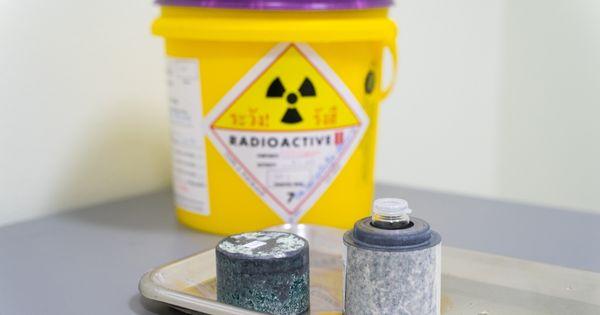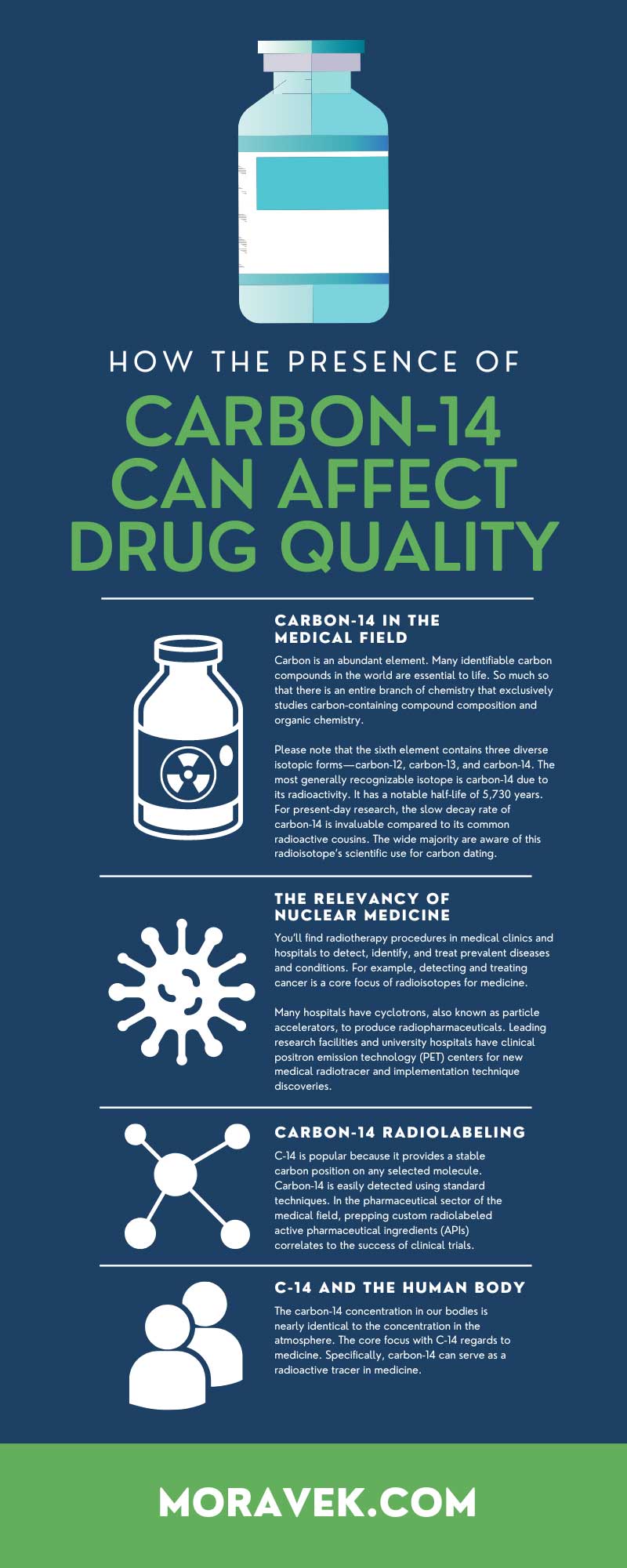
The science behind radioactive materials impacts human lives. In particular, carbon-14 is a prevalent radioactive isotope for medical purposes. They help with diagnostic and treatment solutions for patients. Let’s dive deeper to understand if the presence of carbon-14 can affect drug quality.
Carbon-14 in the Medical Field
Carbon is an abundant element. Many identifiable carbon compounds in the world are essential to life. So much so that there is an entire branch of chemistry that exclusively studies carbon-containing compound composition and organic chemistry.
Please note that the sixth element contains three diverse isotopic forms—carbon-12, carbon-13, and carbon-14. The most generally recognizable isotope is carbon-14 due to its radioactivity. It has a notable half-life of 5,730 years. For present-day research, the slow decay rate of carbon-14 is invaluable compared to its common radioactive cousins. The wide majority are aware of this radioisotope’s scientific use for carbon dating.
The half-life of the radioisotope remains unaltered by external environmental factors. Due to its unique characteristics, this isotope is integral to radiopharmaceutical use in nuclear medicine.
Understanding Radioactivity
According to the U.S. Department of Energy, radioactivity is the release of energy from the decay of the nuclei of certain kinds of atoms and isotopes. Atomic nuclei have protons and neutrons bound together at the center of atoms.
Radioactive nuclei are unstable and decay by emitting energetic particles such as photons, electrons, neutrinos, protons, or neutrons. The degree of radioactivity depends on the fraction of unstable nuclei and how frequently those nuclei decay.
Scientists use radioactivity for medical purposes like medical imaging, cancer treatments, radiometric dating, and further research regarding the laws of nature. Qualified medical researchers and healthcare professionals obtain batches of radioisotopes, like carbon-14, from laboratories and medical facilities.
In particular, carbon-14 helps scientists study abnormalities of the human metabolism that indicate diabetes, gout, and anemia. Scientists developed scanning devices and techniques, including tomography and magnetic resonance imaging.
The Relevancy of Nuclear Medicine
Worldwide, hospitals and medical centers understand the benefits of radiopharmaceuticals. In fact, many patients receive treatment, therapy, or diagnosis through the use of radioactive isotopes. Nuclear medicine is exceptionally relevant in current medical practices. In many cases, facilities have a separate department for nuclear or radiation medicine.
This department handles radionuclides and understands safe and effective practices. Furthermore, they know specialized environmental precautions, post-use operating procedures, and waste disposal. The practices ensure radiation exposure stays within safety limits.
You’ll find radiotherapy procedures in medical clinics and hospitals to detect, identify, and treat prevalent diseases and conditions. For example, detecting and treating cancer is a core focus of radioisotopes for medicine.
Many hospitals have cyclotrons, also known as particle accelerators, to produce radiopharmaceuticals. Leading research facilities and university hospitals have clinical positron emission technology (PET) centers for new medical radiotracer and implementation technique discoveries.
Don’t forget about the drug research and development companies that require manufacturing services for clinical trials of professional-grade pharmaceuticals. The organizations use carbon-14 radiolabeling and synthesis for their tracing studies.
Carbon-14 Radiolabeling
A leading radiolabeled compound application is the study of absorption, distribution, and metabolism in human beings. The data collection is critical because it defines a particular drug’s function and effectiveness through its metabolic rate. Although the presence of carbon-14 has no notable effect on the biological properties of drugs, researchers see results in absorption.
Researchers use carbon-14 for the isotopic labeling of molecules to test the safety and efficiency of drug products within the human body. Radiolabeling can uncover newer metabolic pathways or track the metabolism route of new pharmaceutical molecules.
C-14 is popular because it provides a stable carbon position on any selected molecule. Carbon-14 is easily detected using standard techniques. In the pharmaceutical sector of the medical field, prepping custom radiolabeled active pharmaceutical ingredients (APIs) correlates to the success of clinical trials.
Data Quality
As mentioned, radiolabeling knowledge and experienced expertise are key to manufacturing quality carbon-14 compounds suitable for use in clinical trials. Acquiring reliable quantitative and qualitative data is the main focus of pharmaceutical research and development. The ability to produce consistent results is why carbon-14 is the best choice for radiolabeling.
Labeling an active pharmaceutical ingredient with carbon-14 is ideal because of its inherent properties. The radioactive form of carbon, the core of all organic molecules, is the foundation of radiolabeled pharmaceutical drugs due to its metabolic stability.
Scientists know that C-14 radiolabeled material is a prerequisite for specific clinical studies to receive the best possible analysis. With critical detection technology, carbon-14 assists in the sensitive detection of an active substance. It also detects the reaction and breakdown of products.
Custom Synthesis
Using radiolabeled compounds comes with various challenges beyond traditional chemical synthesis. With the release of energy from the decay of the nuclei, C-14 emits non-ionizing radiation. Thus, allocating safer handling capabilities than gamma-emitting isotopes.
Chemists can incorporate C-14 into the carbon framework of an API without the need to alter the chemical structure because it’s a stable label. That said, carbon-14 remains superior for preparing radiolabeled compounds and performing more customized synthesis.
It’s essential to note that researchers must use radioactive elements to examine and evaluate a drug’s toxicological profile.
That said, drugs synthesized by custom carbon-14 radiolabels use the first radioactive element of choice and can easily trace distribution in the human body for safety and efficiency purposes.
C-14 and the Human Body
The carbon-14 concentration in our bodies is nearly identical to the concentration in the atmosphere. The core focus with C-14 regards to medicine. Specifically, carbon-14 can serve as a radioactive tracer in medicine.
In a diagnostic test for Heliobacter pylori (a bacteria that causes stomach infection), the urea breath test has 37kBg of carbon-14 fed to a patient.
If a patient has an H. pylori infection, the bacterial enzyme breaks down the urea into ammonia and radioactively labeled carbon dioxide. Low-level counting of the patient's breath can detect this diagnosis.
What About Oxaliplatin?
A radio-conjugate with the platinum agent oxaliplatin labeled with the isotope carbon C-14 can help doctors predict the response to oxaliplatin therapy using accelerator mass spectrometry (AMS).
After administering a microdose of carbon C-14 oxaliplatin, the oxaliplatin links to DNA and forms mono- and di-DNA adducts. Scientists measure the platinum-DNA adduct formation through the quantification of C14-labeled drug-DNA adducts with AMS.
By measuring the micro dose-induced DNA, doctors can predict (and assess) the response to oxaliplatin-based chemotherapy.
Turn to Moravek for chemical purity determination. Depending on your package, our services include radiochemical injection, a PDF version of the integrated radiochromatogram, and a certificate of analysis. Our skilled team of chemists have extensive knowledge and use various techniques and procedures for radiochemical purity. Contact us to learn more about our facilities.

